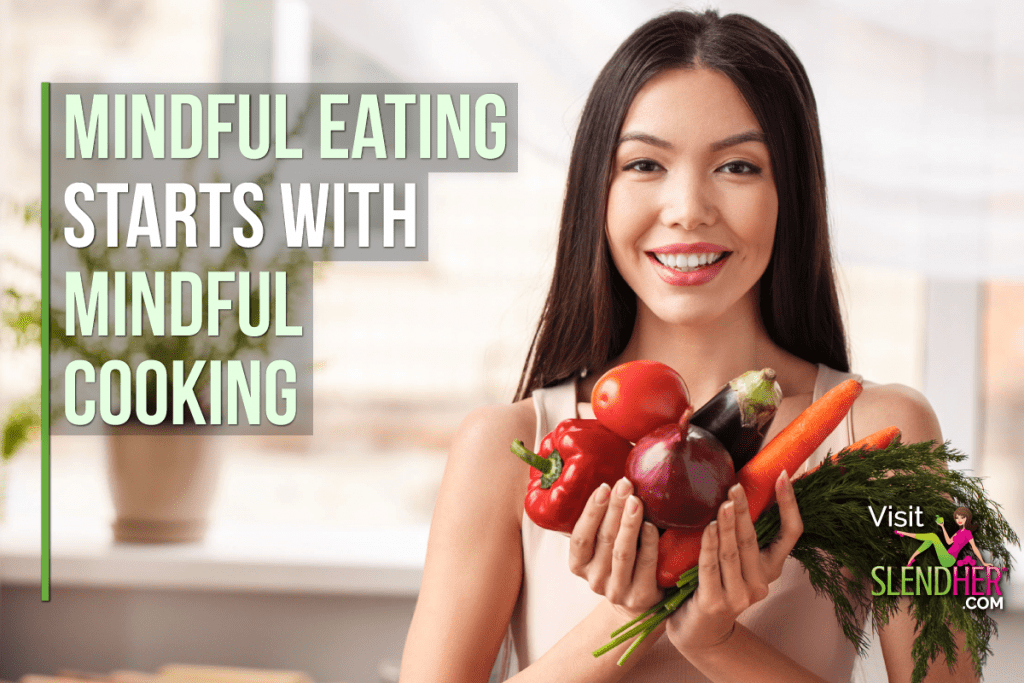Have you ever had one of those days (OK, weeks?) where you set out just to indulge in one cookie and before you know it the jar is nothing by crumbs? But worse than having devoured all your kids’ favorite snacks is you weren’t even aware you did it. If this sounds even slightly familiar, you just did the opposite of mindful eating.
Mindful eating is a great way to be more aware of the foods–and portions–you’re putting into your body. But it’s a little bit of a chicken and egg conundrum–barring less healthier eating out, what are you going to eat if you don’t prepare a meal? You have to eat every day, multiple times per day in fact, and thus perhaps mindfulness should actually start when you’re prepping and cooking your food.
First Course: Let’s Dig into Mindful Eating
When you put the senses to work, mindful eating can get pretty deep. On the surface, eating seems to be just insert food and swallow. But make it mindful and you discover…

- A dimension of flavors.
- How a meal affects your body’s energy, be it a Salt-n-Peppa level of pumped or a more post-Turkey Day type of sluggishness.
- Thoughts connected to your food, such as childhood memories or images of places you’ve traveled.
- How food makes you feel emotionally, such as a comforting bowl of tomato soup or a refreshing salad with veggies picked from your own garden.
Mindful eating is easier in the beginning if you eliminate distractions. That doesn’t mean you need to hole up and serve up your supper solo. But it wouldn’t hurt to clear the clutter from your dining room or kitchen table and use it for what it was intended. Turn off TVs and radios, power down smart gadgets, close up newspapers and magazines, and show up to your meal. Chew each bite longer that you normally would, and find joy in the simple pleasure of nourishing your body.
Second Course: Let’s Get Cooking…with Mindfulness
Now that you’ve worked up an appetite for mindful eating, let’s move the prep work to the kitchen. Just as you relied on your senses for mindful eating, it’s time to do the same with mindful cooking.
- Sight: They say you eat with your eyes first, so give them a show. Take in the colors and shapes of the ingredients you’re using. How is one bell pepper different from another? What variations can you see in different grains of brown rice?
- Smell: The aroma of a dish enhances how it tastes, since your senses of smell and taste are pretty much always partnered up at meal time. Open up your spice cabinet and let your nose guide you on a tour of potential flavors. Compare dried spices blends to the fresh ingredients. Which one is more fragrant? How does dried basil smell in comparison the fresh clipped leaves from an herb garden or farmers’ market?
- Taste: Cooking can change the ways some ingredients taste. For foods that don’t require cooking to eat, savor the flavors by tasting bites of the items you’ll be using. It will also help to build an intuition toward how little or how much of something should be used when cooking. Regardless of what the recipe says, sometimes it’s just better to go with your gut.
- Touch: The texture of food plays a role in mouthfeel. Give yourself permission in the kitchen to play with your food in a way that might not be acceptable at the dinner table. Compare the skin texture of a cucumber to a zucchini. They look similar, but do they feel the same? Can you recognize an ingredient by closing your eyes and only using your hands?
- Sound: This one might seem the odd sense out, but ingredients make noise, too. Think about the snap of an asparagus spear as you break off the tough piece. What noise does your knife make slicing through a carrot versus a tomato? And don’t forget all the sizzling, cracking, and snapping when food meets a hot pan.
As you relish in the sensory symphony created in the kitchen, mindfulness settles in, creating a more in-the-moment style of cooking. Instead of watching a show on your tablet while you prep, reading texts while you stir, or leaving the kitchen for moments to take on other tasks, try slowing down and seeing how it changes your mental state and relationship with food.
What ways help you to slow down and become more mindful–in or out of the kitchen? Share with others in the comment!


Leave a Reply